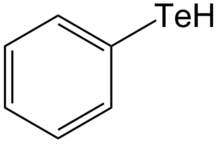Tellurol
Tellurols are analogues of alcohols and phenols where tellurium replaces oxygen.[1] Tellurols, selenols, and thiols have similar properties, but tellurols are the least stable.[2] Although they are fundamental representatives of organotellurium compounds, tellurols are lightly studied because of their instability. Tellurol derivatives include telluroesters (RC(O)TeR') and tellurocyanates (RTeCN).

Properties
Alkyltellurols are yellow liquids with a strong odors. Aryltellurols form colorless crystals. More stable than these compounds are the organometallic tellurols. These fairly stable compounds have the formulae (Me
3Si)
3CTeH, (Me
3Si)
3SiTeH, and (Me
3Si)
3GeTeH.
Acid–base properties
The acidity of tellurols can be inferred by the acidity and dissociation constant of hydrogen telluride, H
2Te, which has a (first) pKa of 2.64 corresponding to a dissociation constant of 2.3 × 10−3.5. H
2Te has a lower pKa and higher dissociation constant than H
2S and H
2Se.[3]
The absence of hydrogen-bonding explains the low boiling temperature of tellurols.[3] The Te–H bond in tellurols is weak. Tellurols are easily oxidized and decompose thermally. Ultraviolet light also induces decomposition. Methanetellurol decomposes to dimethyl ditelluride and hydrogen.
Preparation
The first tellurol to be synthesized, ethanetellurol, was prepared in 1926 via the Grignard reagent.[1] The most frequently used method involves reduction of the ditellurides (R
2Te
2).
See also
References
- Sadekov ID, Zakharov AV (1999). "Stable tellurols and their metal derivatives". Russ. Chem. Rev. 68 (11): 909. doi:10.1070/rc1999v068n11abeh000544.
- Khater B, Guillemin JC, Bajor G, et al. (2008). "Functionalized Tellurols: Synthesis, Spectroscopic Characterization by Photoelectron Spectroscopy, and Quantum Chemical Study". Inorg. Chem. 47 (5): 1502–1511. doi:10.1021/ic701791h.
- Patai S, Rappoport Z, eds. (1986). The Chemistry of Organic Selenium and Tellurium Compounds. 1. Chichester England: John Wiley & Sons Ltd. doi:10.1002/9780470771761. ISBN 9780471904250.